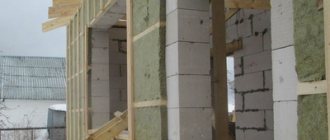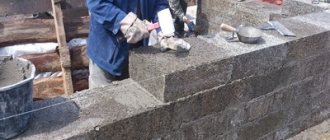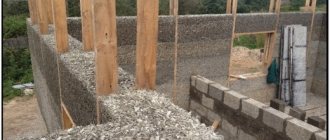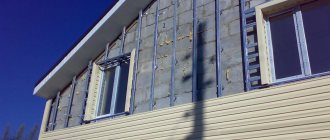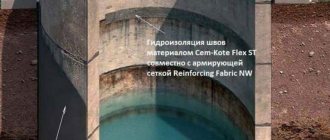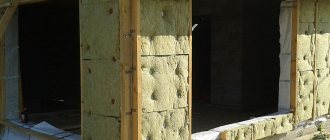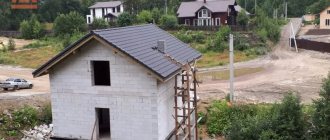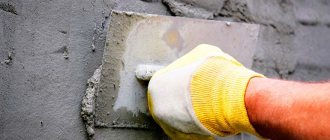The selection of material for insulation of any house is carried out at the very beginning of the development of a project for a future building - directly when choosing material for the walls. Log houses where the wall thickness reaches thirty centimeters or more are not insulated at all (it is enough to caulk the gaps). What about wood concrete houses? After all, this building material consists of wood and concrete. Let's take a closer look.
Not recommended insulation
Wood concrete is rarely used as insulation. It is also not recommended to seal it with polystyrene foam. The material has the following disadvantages for this design:
- Expanded polystyrene suffers from direct sunlight. It releases toxic substances that are dangerous to humans and the environment.
- Steam cannot pass through penoplex. When using the material, you will need to additionally think about room ventilation. Arbolite is used to maintain heat indoors. In combination with polystyrene foam, this advantage will be completely absent.
The material can be used as thermal insulation for blind areas and utility rooms. The outside of the house is insulated with penoplex only in case of emergency.
Features of thermal insulation with wood concrete
If wood concrete insulation is carried out using appropriate slabs, then it is necessary to use special solutions for their installation. They prevent the development of bridges through which cold can penetrate into the room, and increase the thermal insulation qualities of the material as a whole. Experts recommend:
- perlite solutions;
- sawdust concrete solutions with the addition of calcium chloride or aluminum sulfate.
If all conditions are met, you will receive a very warm and inexpensive home in which coziness and comfort will reign.
Sources
- https://betonov.com/vidy-betona/arbolit/kak-uteplit-dom-iz-arbolita-snaruzhi.html
- https://mezhvencov.ru/statyi/ytepliteli/arbolit-kak-uteplitel-ego-plyusy-i-minusy.html
- https://ruarbolit.ru/technologija/uteplenie-sten-arbolitom/
- https://www.stroysprint.ru/articles/arbolit-makes-warmness.html
- https://remstroisovet.ru/chem-uteplit-dom-iz-arbolita.html
- https://uteplitel-x.ru/uteplenie-arbolitovogo-doma-snaruzhi-iznutri/
Mixed type heat insulators
Mixed insulation materials are made from asbestos mixtures to which mica, dolomite, perlite or diatomite are added. Also, mineral components are introduced into the material, which serve to bind the base. The starting raw material has the consistency of a thin dough. While it has not yet hardened, it is applied to the desired location and waited for it to dry. Molding products are also made from this material: plates and shells.
This characteristic of insulation of this type, such as heat resistance, is clearly at its best. Asbestos-based insulation can easily withstand temperatures of 900 degrees. True, their numerous pores absorb moisture too well, so in this case it is impossible to do without waterproofing. Asbestos dust is dangerous for humans, especially for allergy sufferers, therefore strict adherence to sanitary standards when using such insulation is necessary. The most commonly used asbestos heat insulators are Sovelite and Vulcanite. Their thermal conductivity ranges from 0.2 watts per meter per Kelvin.
How and with what to insulate a wood concrete house
Expanded polystyrene (foam plastic and penoplex) is a flammable material and at the same time it emits styrene. Styrene can be released at room temperature, the substance affects the liver and can lead to infertility. Extruded polystyrene foam is best used for insulating strip foundations, blind areas and other structures from the street, since the material does not absorb moisture.
Mineral wool with insufficient hydro- and vapor barrier absorbs water and loses its heat and sound insulation properties. When insulating walls from the inside, mineral wool is attached to the walls using a frame made of timber or profile. The vapor barrier is laid on the insulation from the side of the warm room so that the mineral wool does not absorb moisture from the warm air of the living room.
Sawdust and ecowool are environmental insulation made from cellulose, used mainly for insulating walls between wood concrete blocks and brickwork. You can also use polyurethane foam (polyurethane foam), fine expanded clay or polystyrene foam slabs to fill voids in the wall. If the walls have already been erected, then the facade can be insulated from the outside and then finished with vinyl siding.
Detailed comparison of the characteristics of wood concrete and aerated concrete
To compare the properties of materials, we used technical data for structural blocks of identical strength class B2.5 - wood concrete with a density of 600-750 kg/m3 and aerated concrete with a density of 400 kg/m3:
- Thermal conductivity.
Arbolite retains heat worse - the thermal conductivity coefficient is 0.12-0.15 W/(m*0C), while for aerated concrete it is 0.09-0.1 W/(m*0C). - Frost resistance.
Cellular concrete can withstand up to 100 cycles, while wood concrete can withstand up to 50 cycles at best. The service life of each of them is accordingly. - Moisture absorption.
Wood concrete is the least moisture resistant, as it can absorb from 40 to 85% of moisture. Let's add to this the possibility of having up to 5% of wood affected by rot, which is regulated by GOST 2140-71. What is the end result and what will be the real, and not theoretical, service life of a house made of wood concrete? - Flexural strength.
Aerated concrete blocks are fragile, therefore they are characterized by minimal resistance to bending loads. Arbolite, according to reference data from manufacturers, can withstand higher loads and, even after short-term exposure to extreme values, is able to restore its shape. But from a practical point of view, if the foundation is deformed, then the stresses will be permanent. And in this case, wood concrete will not last long - the formation of cracks cannot be avoided. Therefore, both block materials require a strong and solid foundation. - Fire resistance.
Another “advantage” of wood concrete is that it does not support combustion. This is supposedly achieved by coating wood chips with a layer of a binder called cement. But the block consists of 90% chopped wood. It’s easy to come to the conclusion that walls made of wood concrete will simply collapse in a strong fire - not a fact, of course, but with a 90% probability. And in the worst case, aerated concrete will become very smoky, since it is an artificial, non-combustible material. - Weight.
Arbolite weighs much more, since it does not have voids in the structure. This increases the load on the foundation. - Dimensions.
Arbolite blocks are smaller and thinner than aerated concrete, and the masonry is made using cement-sand mortar. It follows from this that the walls are colder and there are more “cold bridges”. This means that insulation is required, and when building walls from aerated concrete, it is enough to use blocks with a thickness of 375-400 mm (depending on the specific region) and you will not have to add additional insulation to the house.
Again, all the above characteristics are comparative and may differ depending on the specific manufacturer. But the difference will be insignificant, so this fact does not affect the final result of the comparison.
It is also important to note the fact that if aerated concrete is produced exclusively in factory conditions (i.e., taking into account all the requirements), then wood concrete is often produced using a handicraft method
This can cause not only significant deviations in size, but also non-compliance with the declared technical and operational characteristics.
Production of wood concrete:
Production of autoclaved aerated concrete:
Quantity calculation and price
In order to guarantee the long service life of a wood concrete house, you must carefully select the laying building material and pay attention to the following indicators:- The price should not be lower than the market price, otherwise you can purchase low-quality blocks; the average market price today for wood concrete blocks is 4,000 rubles.
- The AB seller must have a quality certificate.
- The structure of the block is homogeneous; when viewed, its constituent components should not be visible.
- The shape and size of the block must comply with the standard; the elements must not differ from each other.
- The color of the blocks is gray; a different color indicates a violation of the manufacturing technology and poor-quality composition of the block mass.
- The appearance of the block should be smooth, dense, without voids between the wood chips.
The volume of material directly depends on the method adopted. An exact calculation is carried out when developing a project for a house and is indicated in the material specifications. For rough calculations, developers use area formulas based on the dimensions of the house in plan.
For example, for the construction of a one-story building made of wood concrete with a plan of 10x10 m and a structure height at the corners of 3 m :
- First, determine the perimeter of the walls: 10x2+10x2=40 m.
- Set the total area of the walls: 40x3=120 m2.
- Window area: 5 pieces x 1.2 m x 1.0 m = 6 m2.
- Door area: 2 units x 2 m x 1.0 m = 4 m2.
- Net wall area: 120-6-4=110 m2.
- Choose a block size of 500*400*250 mm.
- Block weight, 30 kg.
- Choose the thickness of the walls, 0.4 m.
- The thickness of the mortar in the masonry is 5 mm.
- Reinforcement through 5 rows.
- Total number of blocks: 854 pcs.
- Total weight of blocks: 25620 kg.
- Total volume of blocks: 42.7 m3.
- Number of blocks per 1 m3: 20 pcs.
- Weight of 1 m3 blocks: 600 kg.
- Total price of blocks: 170,800 rub.
- Total amount of solution: 1.281 m3.
- Total weight of the solution: 2433.9 kg.
- Total weight: 28053.9 kg.
- Number of rows including seams: 12 pcs.
- Quantity of masonry mesh: 78.43 m.
- Optimal wall height: 3000 mm.
- Load on the foundation from the walls: 0.175 kg/cm2.
In this article, read more about the prices for construction from wood concrete blocks.
Compound
The wood concrete mixture may contain various components. According to GOST 19222-84, wood concrete must consist of several components.
Organic filler – wood chips. To obtain quality blocks, wood particles with dimensions not exceeding 30, 10 and 5 mm in length, width and thickness, respectively, should be used. In addition, the content of polysaccharides in wood should not exceed 2%. The organic filler should not contain fungal elements or various mechanical inclusions. Depending on the type of wood concrete, the wood chip content ranges from 75 to 90%.
Cement binder. Portland cement of a grade not lower than M400 should be used as such a filler. Some manufacturers offer blocks made from frost-resistant cement. It should be noted that during long-term storage, cement blocks lose their original characteristics, which is why they may not meet the requirements stated by the manufacturer.
Components of chemical origin. Arbolite blocks partly consist of organic fillers, which tend to rot. To avoid damage to wood chips by fungus, various chemical additives are added to the mixture. These may be calcium or ammonium chlorides, aluminum sulfate or other inorganic substances. Such components are harmless to human health. They allow not only to protect wood chips from premature deterioration, but also to speed up the process of adhesion of the components of the wood concrete mixture, while reducing the drying time of the blocks.
Water is also used to create wood concrete. Its quality is regulated by GOST 23732-79. The water should not contain fats, lipid derivatives, or coloring components. Only fresh liquid is used to produce blocks.
Before starting the technological process, water and chemical components are subjected to laboratory tests. They are carried out regularly for each newly received batch.
Arbolite thermal insulation options
- Insulation of walls with panels 820 x 620 x 100 mm. They have optimal sizes: such that the elements are easy to install yourself, while reducing the number of seams to the possible minimum.
- Floor insulation with panels 820 x 620 x 80 mm. This panel differs from the previous one in thickness: practice shows that 80 mm is enough to insulate any ceiling.
Arbolite is a universal thermal insulation material that works equally well where it is necessary to keep warm or, conversely, cool. The house itself made of wood concrete does not need to be insulated.
Basic materials for insulation
Wood concrete and insulation are recommended to be used in tandem for the construction of a building in Russian conditions. Some owners decide to leave the material without an additional layer. In this case, the wall should be at least 30 cm thick. This is a budget option. A facade should be built with a thickness of 37 cm. Thanks to this, significant savings will be possible. How to insulate wood concrete, the thickness of which is 30 cm? The layer must be at least 5 cm. Additionally, vinyl siding is mounted on top.
It is not recommended to insulate a house with polystyrene foam. In this case, the wood concrete will completely lose its vapor-permeable properties. When using this material in a building, additional ventilation will be required. This option is unacceptable, because it leads to significant heat loss. However, penoplex can be used to seal cracks on blind areas. What is the best way to insulate a house made of wood concrete? It is recommended to choose materials that do not interfere with the natural circulation of air inside the wall surface.
In central Russia, it is recommended to install walls made of wood concrete with a thickness of at least 30 cm. Insulation on top is carried out with mineral wool. Its thickness on the outside of the building should be at least 10 cm. We have already figured out whether the walls need to be insulated. Now let’s highlight the advantages of this type of material:
- A simple and cheap way to insulate. The surface will be properly ventilated.
- There is no need for preliminary preparation of the wood concrete surface. Mineral wool is attached to the sheathing or without it.
- The material retains moisture, but does not interfere with natural evaporation.
- Insulating a wooden house from the outside with wood concrete also requires an outer layer of mineral wool. Over time, you can only change one slab, and not the entire surface.
Ecowool is also considered an excellent option for insulating wood concrete. The material is completely natural. It is made from cellulose with the addition of a small amount of boric acid. It is recommended to insulate wood concrete in a bathhouse with this material, because it cannot harm the human body. Installation is carried out using glue or dry method.
Ecowool, as a material for wood concrete insulation, has the following advantages:
- Environmentally friendly composition.
- Installation is carried out by blowing. Additionally, you can use the dry or glue method.
- The composition does not contain harmful toxic components that can negatively affect human health.
- Insulating the ceiling with wood concrete will cost much more. Ecowool can be combined with wooden coverings. The material will not allow mold or mildew to form. Insects and rodents cannot live and reproduce in such a surface.
- To install insulation, special equipment is required. The result is a coating without seams. To do this, you will need to contact specialists in this matter. Unfortunately, you will have to pay extra for their services.
- The work is done quickly and efficiently. In this case, the coating will last a long time and without visible damage.
The choice of insulation directly depends on the preferences and financial capabilities of the owner. In this case, one should take into account the main features of the material that was used to build the walls. Proper insulation of wood concrete will create optimal conditions for indoor living at any time of the year. Otherwise, the risk of walls freezing in winter increases.
How to insulate a house made of wood concrete?
If the decision to insulate a house from wood concrete is nevertheless made, then almost any thermal insulation material can be used for these purposes. The walls of an arbolite house are usually compared with wooden ones, and wood, as is known, has excellent vapor permeability, which allows you to choose from any insulation material you like.
This can be either polystyrene foam, as a budget option, or something more expensive, for example, the same penoplex. The difference will only be in the density of the insulation, its cost and some other performance qualities. It should be understood that arbolite walls are very fragile, which negatively affects the fixation of fasteners inside them.
Therefore, before insulating a house from wood concrete, you should think about this point in advance and choose dowel umbrellas of a suitable diameter and size. You can insulate a house made of wood concrete using mineral wool. However, this will require assembling a sheathing, into which this insulating material could then be laid.
In addition, the sheathing will have to be finished with something on the outside; perhaps someone will prefer siding, while others will prefer lining; there is not much difference (except for aesthetics).
Selection and comparison criteria
A thorough approach to data analysis guarantees the optimal selection of the most suitable material properties
You are building a house for many years, so it is necessary to take into account not only strength, many other properties are also important:
- thermal insulation characteristics;
- moisture resistance;
- frost resistance;
- environmental friendliness;
- fire resistance;
- density;
- sizes.
The above parameters determine how long the structure will last, as well as how safe it will be for its inhabitants.
This article discusses two widely used materials for construction - wood concrete and aerated concrete, and also describes their distinctive qualities.
Is it necessary to insulate a house made of wood concrete?
Wood concrete itself is a very warm material, so houses made from it most often do not require absolutely any insulation. Although, here, again, a lot depends on a particular region, the thickness of the walls of the house and some of its other design features.
As a rule, wood concrete houses are only partially insulated, in those places where one building material replaces another. For example, the section of the house between the wood concrete wall and the window frame is subject to mandatory insulation. Most often, this is where significant heat loss is observed.
In addition, the area of the house near the doors is also subject to careful insulation, since heat can escape through it. As for the roofing of houses made of wood concrete, a lot depends on the materials of the floor. But, most often, it is not worth giving up insulation of the attic and under-roof space, because heat loss through the roof is also very significant.
Criteria for quality products
Choosing wood concrete is a responsible process, since the service life of the future structure, as well as the microclimate inside it, will largely depend on it
Experienced builders, when purchasing material, advise, first of all, to pay attention to its cost. It is unlikely that the manufacturer will work to his detriment and sell high-quality wood concrete blocks below their market price
When choosing wood concrete, it is important to make a visual assessment of it. Below are the quality indicators of such material
- Uniformity of composition. If the wood concrete mixture was heterogeneous, the finished blocks will delaminate over time. According to the regulations, the delamination rate must be less than 10%.
- Correct geometric shape. Its violations are observed when the storage conditions of finished products or production technology are not observed.
- Uniform gray color. Uneven color of blocks or foreign inclusions indicate low quality of the products. For example, the presence of green or brown shades is a sign of under-drying of the products. It is worth considering that materials may have various inclusions (straw, sawdust, pine needles, tree bark), but not more than 5%.
- Chips of the same size (the presence of particles with sizes exceeding the established standards is unacceptable). Wood fractions that are too large are unable to be completely saturated with chemicals. Because of this, they do not mix well with concrete and reduce the strength of the finished building material.
To be sure of the quality of wood concrete, you should agree with the manufacturer on the possibility of laboratory testing of random samples of material from the released batch.
How to do it yourself?
The technological process of creating AB begins with cutting wood chips; for this, only raw wood is used. Then it settles, treated with chemicals to remove sugars. Only raw chips provide a chaotic arrangement in the concrete mass, which is very important for obtaining rigidity and affects the amount of cement.
Standard composition of the solution for creating 1 m3 of arbolite blocks:
- chemical reagents - 10 kg;
- cement - 250 kg;
- wood chips - up to 300 kg.
There are several instructions for creating an arbolite mixture; it is important to remove moisture and sugar from the wood chips as much as possible. When they get into an alkaline cement mortar, due to hydrolysis they are converted into water-soluble sugar, which destroys concrete.
Washing sugar out of wood using reagents:
- slaked lime;
- Na2O(SiO2)n;
- Al2(SO4)3.
These reagents fill the pores of the chips, thereby reducing their ability to absorb water, which reduces the deformation of the block due to swelling/shrinkage cycles, which reduce the overall strength of the AB.
So, how to make wood-concrete material :
- The working mass is mixed in a concrete mixer.
- The molds are filled with the mixture using shovels and compacted using a timber device.
- The compaction process begins after laying the full form and additionally on top of a small mound.
- Experts do not recommend compacting each layer of mass; the more chaotically it is filled in the molds, the better the compaction will be.
- The mass is left in the molds for 3 days.
- Disassemble the forms and dry the AB in air.
A detailed guide to making wood concrete blocks is here.
Photo of the rafter system
Arbolit pros and cons.
Our time is characterized not only by an abundance of construction technologies, but also by a large selection of materials that can be used to build houses for permanent residence. Several decades ago, private developers had to make a choice between two materials. They chose between brick and wood. Depending on their financial capabilities, they purchased the most suitable material.
Given the current reality, the choice is incredibly huge. In addition to wood, developers can choose foam blocks or opt for aerated concrete. In addition, houses can also be built from expanded clay-based materials.
Recently, a material such as wood concrete has begun to gain popularity. We will consider the pros and cons of this material.
Arbolit composition
Advantages of wood concrete.
So, wood concrete, also known as sawdust concrete (chip concrete) or wood concrete. Blocks made from it are inexpensive and at the same time have a wide range of performance characteristics. Many people who want to build an eco-friendly home choose this material. Despite the fact that wood concrete blocks mostly consist of wood chips, they nevertheless delight with their reliability and durability.
Textured wood concrete
The properties of this material largely determine the situation where many developers give preference to it. By building a house from this material, you can get a reliable structure that will not have any impact on health and will not be expensive. Many people do not like the gray appearance of such buildings. However, this problem can be easily solved if the finishing work of the facade walls is carried out using modern materials, which are offered in a wide range in construction stores.
Textured wood concrete
It is necessary to understand that none of the building materials currently offered is without drawbacks. Although wood concrete blocks have many advantages, this unique material also has disadvantages. If you are seriously considering wood concrete as a material for building your new home, then, of course, you should learn about the main disadvantages of this material.
Disadvantages of wood concrete. Disadvantages of the material.
One of its main disadvantages is that it does not tolerate moisture. Therefore, when constructing a structure, the walls of rooms in which high humidity will be present must be made of another more moisture-resistant material, but not wood concrete.
The thing is that this material is made from wood chips, and everyone knows that wood does not tolerate moisture well. Therefore, it is worth abandoning the idea of using this material in rooms with high humidity. If you neglect this recommendation and, for example, make walls from this material in the bathroom, then you will encounter certain problems. The material will absorb moisture, and ultimately this will lead to its performance characteristics being noticeably reduced. As a result, the service life of the structure will be significantly reduced.
However, we note that it is possible to eliminate this drawback. To do this, you can finish walls made of arbolite blocks using modern finishing materials. An excellent option would be to use plaster.
Another disadvantage that you should be aware of is that wood concrete blocks have poor resistance to gases with an aggressive environment.
In addition, this building material has other disadvantages. The basement of the house, which is built from arbolite blocks, must be additionally finished. The main goal of this work is to achieve maximum dryness. In this case, you can ensure a long service life of the structure.
We should not forget that arbolite blocks are 90% wood. For this reason, it is necessary to regularly monitor the condition of the base. In winter, it is necessary to regularly inspect it and ensure effective drainage of water, and also ensure that there is no snow near the base.
Another disadvantage of the material is that such blocks do not have ideal geometry. However, we note that this drawback does not have any effect on the speed of construction work. But it is still necessary when doing masonry to make a choice in favor of a mortar based on cement and sand. In this case, the unevenness of the blocks used during construction will be leveled out due to the mortar.
Wood concrete production
Often, the production of arbolite occurs directly at sawmills, for which arbolite is not the main direction of their activity and they do not have the necessary equipment for its production according to state standards; it also happens that in order to increase the profitability of enterprises, in addition to wood chips, other materials are added to it, which does not increase it quality.
Sugars contained in wood chips and wood filler prevent good adhesion of the binder component, cement. The solution to this problem is only 2, 1) dry the raw materials for several months 2) mineralize the raw materials using chemical components. because It is not profitable for an enterprise to stand idle for several months, then most wood concrete on the market is produced by adding chemical components such as calcium chloride, liquid glass, silicate block, alumina sulfate.
Disadvantages of arbolite blocks:
- A large amount of wood concrete of inadequate quality
- Mandatory protection from direct moisture
- Does not have geometric accuracy
- High price
Only you can give an unambiguous answer to the question which is better: wood concrete or aerated concrete, foam concrete when building a house, as they say, how many people have so many opinions, wood concrete and none of the listed materials are advisable to use when building a wooden house, each of the listed materials has its own advantages and flaws. Wood concrete is expensive but good, it is quite strong and easy to process.
Creating a foundation
Arbolite is also good because a house made from it can be installed on any type of foundation, since this material does not crack if the foundation suddenly begins to sag. The thing is that wall blocks made of wood concrete have a high degree of so-called flexural strength. This strength is also called “fracture strength”. This amazing property of wood concrete makes it possible to use any type of foundation. As a result, you can save a lot on costs related to the construction of the foundation. If a house is built from wood concrete, then, as a rule, a foundation is chosen for it, placed on special bored piles. A good alternative to such a foundation is a strip modification.
At the time of forming the foundation, it is necessary to remember the disadvantages of such a material as wood concrete. One of these disadvantages is poor water resistance. Therefore, when creating a foundation, it is necessary to provide for the construction of high-quality waterproofing for it.
Waterproofing is formed using the following methods:
- The foundation is raised above the ground by approximately 1.5 meters;
- A brick base is created, the height of which is also 1.5 meters.
Arbolite blocks must be placed in lime mortar, which is mixed with a small amount of cement.
How much do bath stones cost?
1. Of the stones purchased in the store, the cheapest are gabbro-diabase. They are recommended as a budget option, having characteristics suitable for a heater at a very affordable price. The cause of the specific odor that spreads from gabbro-diabase when heated is sulfides. You can avoid this trouble if you carefully inspect the stones before purchasing. The price of gabbro-diabase ranges from 25 to 35 rubles per kilogram.
2. Jade and jadeite are available to a narrower circle of consumers. The price for 1 kilogram can reach up to 250 rubles.
3. There is also a free option - the most ordinary pebbles, which can be collected from the nearest body of water. It includes various breeds suitable for use in the bathhouse. The only thing that pebbles cannot boast of is that they have a healing effect on the body.
By adhering to certain rules, you can extend the life of the stones. To do this, you should not water them generously; small portions are enough, but after a shorter period of time. To avoid sharp pops, it is recommended to pour hot water on the heater.
Arbolite blocks: the well-forgotten old
The production of a building mixture from Portland cement and sawdust was first started almost a hundred years ago in economical Europe, which was already suffering from the high cost of wood. The French gave the name to the material, deriving it from the word “arbre”, which means “tree”. The technology gradually improved, and already in the 30s, industrial production of a material called “Durisol” was established in Holland. It spread very quickly throughout the world, and its production was soon established not only in European countries, but also overseas - in Canada and the USA.
Until now, when traveling around European countries, you can come across buildings erected from sawdust concrete, the quality of which is not inferior to modern wood concrete. Houses built 70-90 years ago look great and are not going to collapse.
In our country, the technology for producing wood concrete was mastered in the early 60s of the twentieth century. At that time, about a hundred factories producing arbolite blocks were put into operation throughout the country. However, after the government set a course for the massive construction of concrete block “Khrushchev” buildings, the production of wood concrete was, unfortunately, curtailed and forgotten for a long time. However, it is not difficult to find private houses and outbuildings made from it in our cities, wandering around the private sector neighborhoods.
Application area
Arbolite blocks are successfully used in the construction of walls of small buildings of one, two or three floors. Used for the construction of small country houses. Panels and slabs from this composition were also produced. Blocks produced in the form of large sheets are used for insulation. Gradual improvement made it possible to produce monolithic wood concrete when pouring it into formwork.
Arbolite concrete allows the construction of both partitions inside buildings and load-bearing walls. Suitable for fencing external walls as insulation. Positive thermal and sound insulation characteristics make it popular for this type of construction work.
Wood concrete with a density of up to 500 kg per 1 m3 is used for heat and sound insulation, and from 500 to 850 kg per 1 m3 makes it possible to build structural structures from it.
Requirements for wood concrete walls
The optimal thickness of an arbolite load-bearing wall corresponds to gas or foam concrete and should be at least 300 mm for load resistance conditions and 400 mm for additional thermal protection.
In order to efficiently build walls of this size, the dimensions of the stone are standardized :
- reinforced - 600*300*200 mm;
- wide - 500*300*250 mm;
- medium - 500*300*200 mm;
- narrow - 500*250*150 mm;
- jumpers - 1500*250*300 mm.
The exact calculation of wall thickness must be established by the project. The size will depend on the location of the object, soil characteristics, climatic features and the height of the building.
How and with what to insulate a wood concrete house
Expanded polystyrene (foam plastic and penoplex) is a flammable material and at the same time it emits styrene. Styrene can be released at room temperature, the substance affects the liver and can lead to infertility. Extruded polystyrene foam is best used for insulating strip foundations, blind areas and other structures from the street, since the material does not absorb moisture.
Comparison of insulation materials by thermal conductivity
Mineral wool with insufficient hydro- and vapor barrier absorbs water and loses its heat and sound insulation properties. When insulating walls from the inside, mineral wool is attached to the walls using a frame made of timber or profile. The vapor barrier is laid on the insulation from the side of the warm room so that the mineral wool does not absorb moisture from the warm air of the living room.
Sawdust and ecowool are environmental insulation made from cellulose, used mainly for insulating walls between wood concrete blocks and brickwork. You can also use polyurethane foam (polyurethane foam), fine expanded clay or polystyrene foam slabs to fill voids in the wall. If the walls have already been erected, then the facade can be insulated from the outside and then finished with vinyl siding.
Characteristics of the material according to GOST
The advantage of wood concrete blocks is their low weight, which does not require the installation of a complex foundation.
All blocks must have minimum acceptable indicators for the following characteristics :
- Thermal conductivity is in the range of 0.07 -0.16 W/(m•deg), if the walls are built with the designed thickness, technologically accurately, then such a house will not require additional heat and sound protection.
- The basic GOST for wood concrete blocks requires high bending strength of 0.7 - 1 MPa and compressive strength of at least 0.5 MPa. If the component composition is observed, ABs are capable of providing elastic resistance to significant external mechanical loads, and therefore cracks do not form on the surfaces of the walls, and living in such a cottage is absolutely safe.
- Shrinkage from 0.4 to 0.5%.
- The average density is 650 kg/m3.
- Moisture absorption is set in the range of 40-85%.
- Frost resistance - at least 50 cycles. This parameter allows the walls to withstand freezing/thawing cycles repeatedly, provided that the blocks have been protected from moisture penetration inside.
- Fire resistance. The maximum fire resistance of the material is normatively set in the range of 0.75 -1.5 hours, which ensures good fire safety of the object, despite the fact that the composition contains a lot of wood chips.
- Biostability - group 5.
- Sound absorption at 2000 Hz - 0.6.
Full information about the main technical characteristics in this article.


